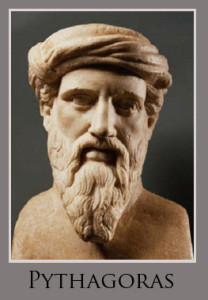Bertrand Russell
Pythagoras
Pythagoras (c570 – c495 BC) was a Greek philosopher and mathematician and probably best known today for the theorm relating to right-angled triangles that is named after him. However, it has been shown that it was known at least a thousand years earlier in Egypt, Babylon and China(a).
that it was known at least a thousand years earlier in Egypt, Babylon and China(a).
>In 2021 Dr Daniel Mansfield, a mathematician at the University of New South Wales discovered that a 3,700-year-old Babylonian clay tablet illustrates the use of what we call ‘Pythagorean triples’ in dividing land, 1,100 years before Pythagoras!(g)<
Although born in Samos he eventually moved to Croton in Magna Graecia, now southern Italy. There, he established a quasi-religious sect of what were in effect were number worshippers.
Wikipedia notes(c) that “Aristotle claimed that the philosophy of Plato closely followed the teachings of the Pythagoreans, and Cicero repeats this claim: Platonem ferunt didicisse Pythagorea omnia (“They say Plato learned all things Pythagorean”). Bertrand Russell, in his A History of Western Philosophy, contended that the influence of Pythagoras on Plato and others was so great that he should be considered the most influential of all Western philosophers.”
Mark Adams in his Meet Me in Atlantis[1070] has touched on the possible Pythagorean influence on Plato’s use of numbers in his Dialogues. With this in mind, Adams visited the late Ernest G. McClain the author of a highly original idea, namely that details contained in Plato’s Atlantis story can be explained in terms of mathematical/musical theory. This was expressed in his 1978 book, The Pythagorean Plato[1082], which can be read online(b), but, be warned, most will find this very technical offering rather heavy going.
In 2010, Dr. Jay Kennedy, an American at the University of Manchester, also claimed to have found evidence of Pythagorean influence in Plato’s dialogues claiming that they contain a regular mathematical structure which relates them to an ancient 12-note musical scale. “Kennedy’s breakthrough, published in the journal Apeiron this week, is based on stichometry: the measure of ancient texts by standard line lengths. Kennedy used a computer to restore the most accurate contemporary versions of Plato’s manuscripts to their original form, which would consist of lines of 35 characters, with no spaces or punctuation. What he found was that within a margin of error of just one or two percent, many of Plato’s dialogues had line lengths based on round multiples of twelve hundred.”(e) A critique(f) of Kennedy’s theory by Professor Andrew Gregory of University College London should be read for balance.
An example of Plato’s regard for specific numbers is his idea that 5,040 is a perfect number and is the ideal population for a polis (city). It is a number divisible by all integers from 1 to 10, which would have had even greater significance prior to the invention of decimals. Some of the other factoids claimed for this number are really scary or at least thought-provoking(d).
(a) https://www.storyofmathematics.com/greek_pythagoras.html
>(b) Wayback Machine (archive.org)<
(c) https://en.wikipedia.org/wiki/Plato#Plato_and_Pythagoras
(d) https://joedubs.com/5040-the-perfect-number/
(e) https://www.theguardian.com/world/2010/jun/29/plato-mathematical-musical-code
(f) https://discovery.ucl.ac.uk/1359825/1/Andrew%20Gregory.pdf
